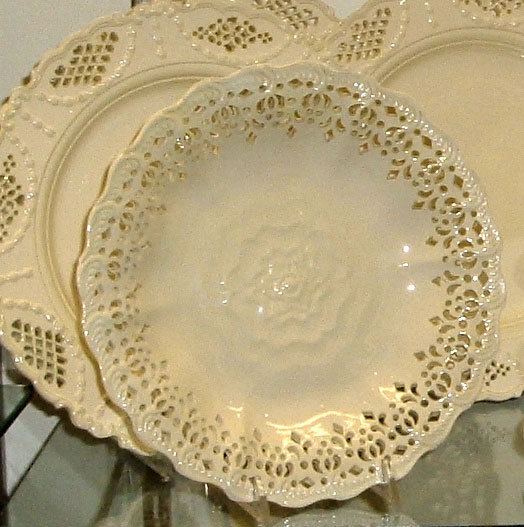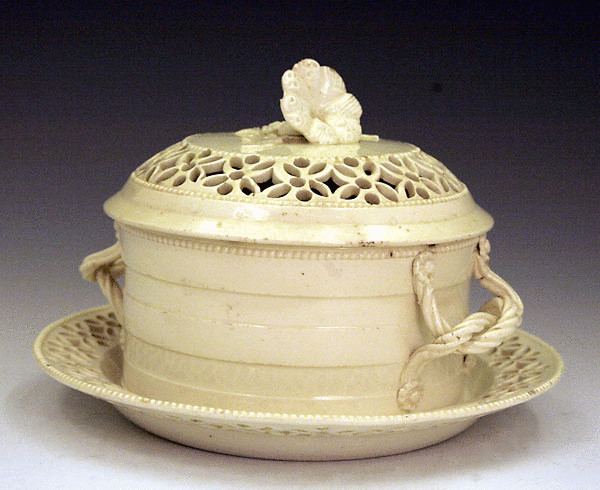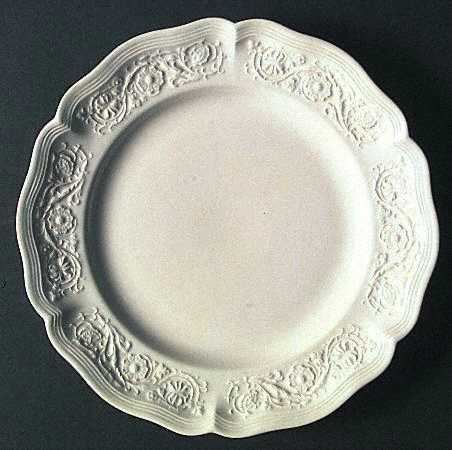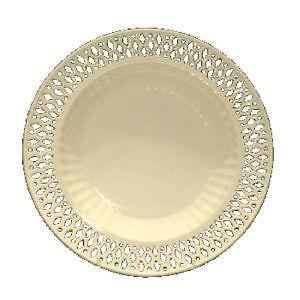 | ||
Minimax asb sonic core creamware
Creamware is a cream-coloured, refined earthenware with a lead glaze over a pale body. It was created around 1740 by the potters of Staffordshire, England, and became a popular domestic ware until the 1840s.
Contents
- Minimax asb sonic core creamware
- Early development
- Later development
- Pearlware
- Forms
- Decoration
- Lead powder
- Tortoiseshell method
- Transfer printing
- Enamelling
- Manufacturers and attribution
- Creamware and the European market
- Decline of creamware
- References

Early development

Creamware is the name given to a type of earthenware pottery which is made from white clays from Dorset and Devonshire combined with an amount of calcined flint. This body is the same as that used for salt-glazed stoneware, but it is fired to a lower temperature (around 800 °C as opposed to 1,100 to 1,200 °C) and glazed with lead to form a cream-coloured earthenware. The white clays ensured a fine body and the addition of flint improved its resistance to thermal shock during firing, whilst flint added to the glaze helped prevent crazing.

Creamware was first produced some time before 1740. Originally lead powder or galena, mixed with a certain amount of ground calcined flint, was dusted on the ware, which was then given its one and only firing. This early method was unsatisfactory because lead powder produced poisoning among the potters and the grinding of flint stones caused a disease known as potter's rot.

Around 1740 a fluid glaze in which the ingredients were mixed and ground in water was invented, possibly by Enoch Booth of Tunstall, Staffordshire, according to one early historian, although this is disputed. The method involved first firing the ware to a biscuit state, and then glazing and re-firing it.
Later development

Foremost of the pioneers of creamware in the Staffordshire Potteries was Thomas Whieldon. Although he has become popularly associated almost exclusively with tortoiseshell creamware, in fact he produced a wide variety of creamware. He first mentions ‘Cream Colour’ in 1749.

The young Josiah Wedgwood was in partnership with Thomas Whieldon from 1754 to 1759 and after Wedgwood had left to set up independently at Ivy House, he immediately directed his efforts to the development of creamware.
Wedgwood rebelled against the use of coloured glazes, declaring as early as 1766 that he was clearing his warehouse of coloured ware as he was ‘heartily sick of the commodity’.
Wedgwood improved creamware by introducing china-clay into both the body and glaze and so was able to produce creamware of a much paler colour, lighter and stronger and more delicately worked, perfecting the ware by about 1770. His superior creamware, known as ‘Queen's ware’, was supplied to Queen Charlotte and Catherine the Great and later became hugely popular. There were few changes to creamware after about 1770 and the Wedgwood formula was gradually adopted by most manufacturers.
Pearlware
One important ware of note however is pearlware, of which there was an increase around 1779. Pearlware is distinct from creamware in having a blue-tinged glaze produced by the use of cobalt and a body somewhat modified to produce a ware that was slightly greyish in appearance. Pearlware was developed in order to meet demand for substitutes for Chinese porcelain amongst the growing middle classes of the time. By around 1808 a fully whitened version of creamware (known as White Ware) was introduced to meet changing market demand.
Forms
During the partnership between Thomas Whieldon and Josiah Wedgwood from 1754 to 1759, moulded creamware in a variety of forms was developed, especially in collaboration with the talented block-cutter William Greatbatch, who produced a variety of Cauliflower, Pineapple, Fruit Basket and other popular wares. There was considerable inventiveness of form and the use of moulds allowed both greater complexity and ease of mass-production. Combined with increasingly sophisticated decorative techniques, creamware quickly became established as the preferred ware for the dinner table amongst both middle and upper classes.
Decoration
Creamware during the 18th century was decorated in a variety of ways:
Lead-powder
The early process of using lead-powder produced a brilliant, transparent glaze of a rich cream colour. Small stamped motifs similar to those used at the time on salt-glaze wares and redware were sometimes applied to the ware for decoration. Dry crystals of metallic oxides such as copper, iron and manganese were then dusted onto the ware to form patches of coloured decoration during firing.
Tortoiseshell method
The early lead-powder process led directly to the development of the tortoiseshell method and other coloured glazes which were used with the new fluid glazes. Here, patches of colour were sponged or painted onto the biscuit surface before a clear glaze was applied to the whole and then fired. Coloured decoration could help disguise imperfections that might arise during the firing process.
Transfer-printing
Transfer-printing of pottery was developed in the 1750s. There were two main methods, underglaze printing and overglaze. For overglaze printing, an engraved copper plate was prepared and rubbed with oil. The surplus oil was wiped off and an impression was taken onto thin paper. The oily print was then transferred to the glazed earthenware surface which was then dusted with finely ground pigment in the chosen colour. Excess powder was then removed and the ware was given a short firing in a muffle kiln to soften the glaze, burn off the oil and leave the printed image firmly bonded to the surface.
This method could be varied by transferring the oily print onto a ‘glue-bat’ – a slab of flexible gelatine that could be laid on the workbench whilst a globular pot was carefully rolled over it. Glue-bats allowed more subtle engraving techniques to be used. Underglaze transfer printing was also sometimes used, directly onto the porous biscuit body.
Transfer-printing was specialist and so generally outsourced: Sadler & Green of Liverpool were exclusive printers to Josiah Wedgwood by 1763, for example.
Enamelling
By 1760 creamware was often enamelled for decoration, using a technique adopted from the early porcelain industry. This consisted of painting overglaze on the ware with pigments made from finely powdered coloured glass and then firing again to fuse the enamel to the ware. The varied enamel colours did not fuse at the same temperature so several firings were generally needed, adding to the expense.
Manufacturers and attribution
There were approximately 130 potteries in North Staffordshire during the 1750s, rising to around 150 by 1763 and employing up to 7,000 people – a large number of these potteries would have been producing creamware.
Whilst Staffordshire had taken the lead, creamware came to be developed in a number of large potting centres where stoneware was already being produced, eventually replacing stoneware entirely. These included Derbyshire, Liverpool, Yorkshire (including the Leeds pottery) and Swansea.
Attribution of pieces to particular factories has always been difficult because virtually no creamware was marked prior to Josiah Wedgwood's manufacture of it in Burslem. At the time manufacturers frequently supplied wares to one another to supplement stocks and ideas were often exchanged or copied. In addition, factories usually sent out their wares to outside specialist enamellers or transfer-printers for decoration – decoration in-house was only gradually adopted. For this reason, several manufacturers usually shared the same decorator or printer and tended to use the same or very similar patterns.
This is frustrating for collectors, dealers and curators alike in their efforts to ascribe pots to individual factories: this is frequently impossible. Archaeological excavations of pottery sites in Staffordshire and elsewhere have helped provide some better-established typology to enable progress in attribution.
Creamware and the European market
Wedgwood and his competitors sold creamware throughout Europe and one contemporary writer and friend of Wedgwood claimed it was ubiquitous. This led to local industries developing throughout Europe to meet demand. There was also a strong export market to the United States.
The success of creamware had killed the demand for tin-glazed earthenware and pewter vessels alike and the spread of cheap, good-quality, mass-produced creamware to Europe had a similar impact on Continental tin-glazed faience factories. By the 1780s Josiah Wedgwood was exporting as much as 80% of his output to Europe.
Decline of creamware
The heyday of creamware ran from about 1770 to the rise of painted pearlwares, white wares and stone chinas in the period around 1810 to 1825. Although creamware continued to be produced during the later period, it was no longer pre-eminent in the markets. Given the fickle nature of the consumer, much remarked upon by Wedgwood during his career, it is remarkable how long creamware remained popular in its many forms.
